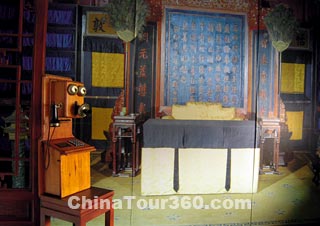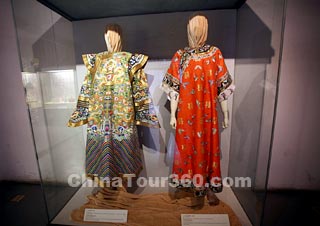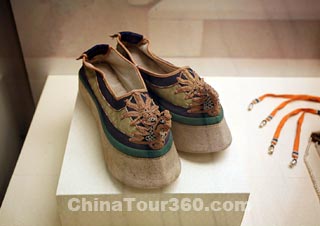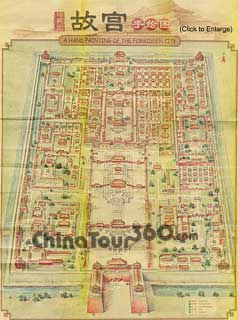Outer East Route of Forbidden City: Nine-Dragon Screen - Huangji Hall - Ningshou Palace - Yangxing Hall - Ningshou Garden - Changyin Pavilion - Yueshi Building - Leshou Hall - Yihe Pavilion - Zhenfei Well
When Emperor Qianlong was young, his grandpa Emperor Kangxi liked him a lot and made effort to make him the crown prince. To show his respect and appreciation to Kangxi, Qianlong promised that he would not be on the throne longer than his grandpa (61 years). So at the 60th year of his reign when he was 85 in 1795, he gave the throne to Emperor Jiaqing seemingly and moved in Ningshou Palace of the Forbidden City. You can reach it by going south from Fengxian Palace and turning east to enter the Xiqing Gate.
The first thing you will see is the Nine-Dragon Screen. There are 3 Nine-Dragon Screens in China, the oldest one from the Ming Dynasty is in Datong, the biggest one with dragons on both sides is in Beihai Park, and this one here in the Forbidden City is the most exquisite one. It is 29.4 meters wide, 3.5 meters tall and combined by 270 colored glazed tiles. If you watch closely, you would notice that the abdomen's color of the third white dragon from the east is a little different. In 1772 when the Nine-Dragon Screen was under construction, an apprentice broke the tile of this part. Because of the high difficulty of baking the glazed tiles, each of them was the only one. It was too late to bake a new one by then and the craftsmen would all get killed if the project could not be finished on time. At that tense moment, the leader of the craftsmen, Ma Dechun, sculpted a tile with nanmu (a kind of rare and hard wood) and painted it to make it look exactly like the old one. When Emperor Qianlong came to inspect the screen, he did not see the difference and the craftsmen were saved. Now after exposing to the weather for hundreds of years, the paint faded away and the difference appeared.
Going through the Ningshou Gate at the north of the screen, there is the Huangji Hall where the Treasure Gallery and Stone Drum Gallery are located. Emperors Kangxi and Qianlong had held three banquets here for people who were over 60 years old. The last one in 1796 had invited 3056 guests and the oldest person Xiong Guopei was 106 years old at that time. This reflected the prosperity of the dynasty in a way. In the three halls of the Treasure Gallery, you will see many valuable royal daily utensils, adornments and jewelries made by gold, silver, jade, emerald, pearls and other gems. Ten stone drums are displayed in the gallery. The inscriptions on the drum-shaped stones recorded the fishing and hunting activities of the emperors of Qin Dynasty and its writing influenced the development of Chinese calligraphy a lot.
|

Nine-Dragon Scree
|
|
|

Royal Telephone
|
|
The next on the route is Ningshou Palace. It is another Manchu style construction except for Kunning Palace. But it is closed for now and the open date is undetermined.
Yangxing Hall of the Forbidden City was the residence of Emperor Qianlong after his abdication. Now it is the 4th hall of the Treasure Gallery for the exhibition of eleven etiquette appliances relating to royal fete, enthronement, wedding and funeral. On the left of Yangxing Hall is a garden which has four yards, but only the first one is open to the public. In the famous Xishang Pavilion, the stone floor was chiseled with a curving ditch called the Ditch of Floating Cups. It is 10 centimeters deep and 27 meters long. To amuse themselves, Emperor Qianlong and his favorite ministers would sit by the ditch composing poems and appreciating operas when the cups of wine were floating around in the circulating water. On the right of Yangxing Hall are Changyin Pavilion and Yueshi Building. Changyin Pavilion has 3 floors and is the biggest stage in the Forbidden City. The design is very ingenious as the 8 wells could strengthen the resonance for better sound effects. Yueshi Building was where the emperor and the concubines sit when enjoying the opera. Now you can see the exhibition of the stage costumes, properties and listen to the retrieved record from the Qing Dynasty.
|

Robes for Empress and Concubine
|
|
|

Shoes Emboridered with Phoenix-pattern Toes
|
|
After going through the Yangxing Hall, you will reach the 5th hall for 26 house decorations in Leshou Hall and the 6th hall for 14 Buddhist relics in Yihe Pavilion. In the 5th hall, there is the biggest jade carving which is 224 cm high, 96 cm wide and weights 5350 kg. The jade stone was from Hetian of Xinjiang Province and then was sculpted in Yangzhou of Jiangsu Province. The whole transfer and sculpture progress had taken 13 years. Another remarkable item is Wonderland Penglai which was a birthday present for Cixi when she was 60. It was carved by Rosewood, 130 cm high, 117 cm long and 96 cm wide. Ornamenting with the Queen Mother of the West, white monkey, god of longevity, eight immortals, sika deer, green cypresses, lucid ganoderma and other beautiful flowers made by jade, golden star stone, turquoise, emerald, carnelian and other rare gems. In Yihe Pavilion, the most impressive relic is a Golden Pagoda which had used 85 kg gold and inset with 293 pearls and 500 gems.
|

Blue and White Pot
|
|
|

Ruyi-scepter
|
|
Walking along the corridor to a small yard, there is the last spot for your whole tour, Zhenfei Well. Zhenfei was the daughter of the Ceremonial Master and had been chosen to be the imperial concubine of Emperor Guangxu. Among all the concubines, Zhenfei was loved the most by Guangxu because of her brightness, passion and support to Guangxu's reform. Therefore, she was hated by Cixi. In 1898 when the reform was failed, Cixi imprisoned Emperor Guangxu and Zhenfei separately. Then in 1900 when the Eight-Power Allied Forces invaded Beijing, Cixi ordered a eunuch named Cui Yugui to drown Zhenfei in this well and then she escaped to Xi’an with Guangxi. Zhenfei was only 25 when she died.
These four routes of the Forbidden City tour cover most of the highlights in this majestic palace complex. The visit may take you a whole day, but the history can not be told within only one day. Once the imperial palace for the royal family, now the scenic spot for the whole word, we wish you enjoy your tour in the Forbidden City.














